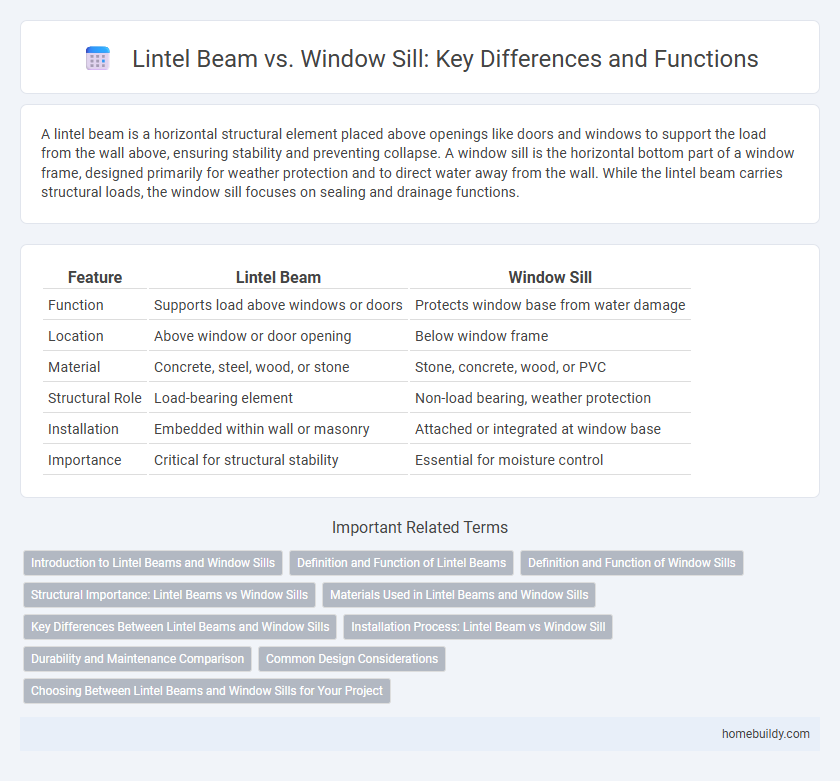A lintel beam is a horizontal structural element placed above openings like doors and windows to support the load from the wall above, ensuring stability and preventing collapse. A window sill is the horizontal bottom part of a window frame, designed primarily for weather protection and to direct water away from the wall. While the lintel beam carries structural loads, the window sill focuses on sealing and drainage functions.
Table of Comparison
| Feature | Lintel Beam | Window Sill |
|---|---|---|
| Function | Supports load above windows or doors | Protects window base from water damage |
| Location | Above window or door opening | Below window frame |
| Material | Concrete, steel, wood, or stone | Stone, concrete, wood, or PVC |
| Structural Role | Load-bearing element | Non-load bearing, weather protection |
| Installation | Embedded within wall or masonry | Attached or integrated at window base |
| Importance | Critical for structural stability | Essential for moisture control |
Introduction to Lintel Beams and Window Sills
A lintel beam is a horizontal structural element placed above window openings to support the load from the wall or roof above, ensuring stability and preventing cracks. Window sills, positioned at the base of the window, serve primarily as a protective ledge that directs rainwater away from the wall, reducing moisture damage. Both lintel beams and window sills are crucial in window construction, balancing structural integrity and environmental protection.
Definition and Function of Lintel Beams
Lintel beams are horizontal structural elements placed above window openings to support the weight of the wall above and prevent cracks or sagging. Unlike window sills, which provide a finishing surface and help direct water away from the window, lintel beams bear the load, ensuring structural integrity. Made from materials like reinforced concrete, steel, or wood, lintel beams distribute loads evenly to adjacent supports, maintaining wall stability.
Definition and Function of Window Sills
Window sills are horizontal structural elements located at the base of window openings, designed to support the window frame and provide a surface for water drainage away from the building facade. Unlike lintel beams, which are load-bearing components placed above windows to distribute structural loads, window sills primarily function to protect the wall from moisture intrusion and enhance durability. Constructed from materials such as stone, concrete, or wood, window sills play a critical role in preventing water damage and ensuring thermal insulation.
Structural Importance: Lintel Beams vs Window Sills
Lintel beams provide critical structural support by bearing the load of the wall above window openings, preventing cracks and ensuring stability. Window sills primarily serve as horizontal ledges that protect the base of the window frame from water infiltration but do not bear significant structural loads. The lintel's role is vital in distributing weight, whereas the window sill's function centers on weatherproofing and aesthetic finishing.
Materials Used in Lintel Beams and Window Sills
Lintel beams are commonly constructed using reinforced concrete, steel, or pre-stressed materials to provide robust structural support above window openings. Window sills typically utilize materials such as stone, brick, or timber, chosen for their durability and aesthetic appeal while facilitating water runoff. The selection of lintel beam materials prioritizes load-bearing capacity, whereas window sill materials emphasize weather resistance and finish quality.
Key Differences Between Lintel Beams and Window Sills
Lintel beams are horizontal structural elements designed to support the weight above a window opening, ensuring load distribution to adjacent walls, while window sills are horizontal surfaces at the base of a window that protect against water infiltration and provide a finished aesthetic. Lintel beams are typically made from reinforced concrete, steel, or wood and bear structural loads, whereas window sills are often crafted from stone, wood, or metal and primarily serve weatherproofing and decorative purposes. The key difference lies in their function: lintel beams provide critical structural support, whereas window sills focus on drainage and exterior finish.
Installation Process: Lintel Beam vs Window Sill
The installation process of a lintel beam involves positioning a reinforced concrete or steel element above the window opening to bear structural loads and distribute them to adjacent walls, requiring precise alignment and support until the beam cures or is secured. In contrast, installing a window sill primarily focuses on placing a horizontal surface at the base of the window frame, which involves ensuring proper slope for water drainage and securing it to the wall substrate with appropriate fasteners or mortar. While lintel beam installation is critical for structural integrity, window sill installation emphasizes weatherproofing and finishing aspects.
Durability and Maintenance Comparison
Lintel beams, typically constructed from reinforced concrete or steel, offer superior durability compared to window sills made of wood or soft stone, which are more prone to weathering and decay. The maintenance requirements for lintel beams are minimal due to their resistance to moisture, pests, and structural stress, whereas window sills demand frequent inspections, painting, or sealing to prevent rot and erosion. Choosing lintel beams enhances the structural integrity and reduces long-term upkeep costs around window openings.
Common Design Considerations
Lintel beams and window sills serve distinct structural and functional roles, with lintel beams primarily designed to bear loads above window openings, ensuring stability by distributing weight from the superstructure. Window sills provide a weather-resistant ledge that directs water away from the wall, preventing moisture penetration and related damage. Common design considerations include material strength for lintel beams to support structural loads, and waterproofing features for window sills to enhance durability and energy efficiency.
Choosing Between Lintel Beams and Window Sills for Your Project
Choosing between lintel beams and window sills depends on the structural and aesthetic requirements of your project. Lintel beams provide essential load-bearing support above window openings, ensuring stability and distributing weight evenly across walls. Window sills, on the other hand, primarily serve as protective ledges that prevent water ingress and enhance the window's visual appeal without bearing significant structural loads.
lintel beam vs window sill Infographic

 homebuildy.com
homebuildy.com